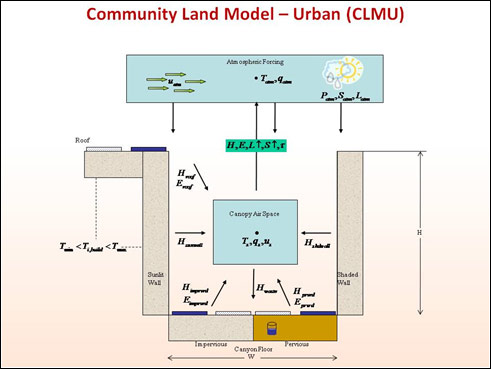CLM: Human Dimensions
CLM addresses several aspects that enable the study of two-way interactions between human activities at the land surface and climate including land cover/land use change, agricultural practices, and urbanization.
CLM includes a treatment of mass and energy fluxes associated with prescribed temporal change in land cover. Using an annual time series of the spatial distribution of PFTs and wood harvest, CLM diagnoses the change in area for PFTs at each model time step and then performs mass and energy balance accounting necessary to represent the expansion and contraction of PFT area. The biogeochemical impacts of land use and land cover change are simulated through changes in CLM carbon pools and fluxes.
CLM includes the option of running with specific mid-latitude crops (maize, temperate cereals, soybean). These crops are represented with more realistic phenology and carbon allocation parameterizations than unmanaged crops. Irrigation is also represented.
The urban environment as simulated in CLM is based on the “urban canyon” concept and allows study of how climate change affect urban energy balance and climate and evaluation of possible urban planning and design strategies to mitigate warming (e.g., white roofs). The canyon system consists of roofs, walls (shaded and sunlit), and canyon floor. The canyon floor is divided into pervious (e.g., to represent residential lawns, parks) and impervious (e.g., to represent roads, parking lots, sidewalks) fractions. The heat and moisture fluxes from each surface interact with each other through a bulk air mass that represents air in the urban canopy layer for which specific humidity, wind, and temperature are prognosed. The urban canopy air temperature can be compared with that from surrounding vegetated/soil (rural) surfaces in the model to ascertain heat island characteristics.


CESM Project
The Community Earth System Model (CESM) is a fully-coupled, global climate model that provides state-of-the-art computer simulations of the Earth's past, present, and future climate states.
CESM is sponsored by the National Science Foundation (NSF) and the U.S. Department of Energy (DOE). Administration of the CESM is maintained by the Climate and Global Dynamics Laboratory (CGD) at the National Center for Atmospheric Research (NCAR).
CLM Overview
CLM Model Description
- Surface Heterogeneity
- Biogeophysics
- Hydrologic Cycle
- Biogeochemistry
- Human Dimensions
- Ecosystem Dynamics

